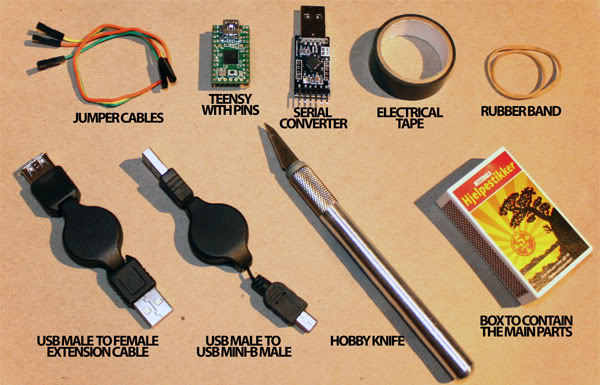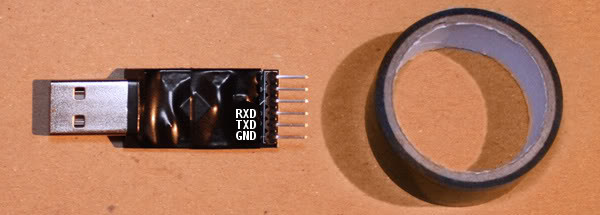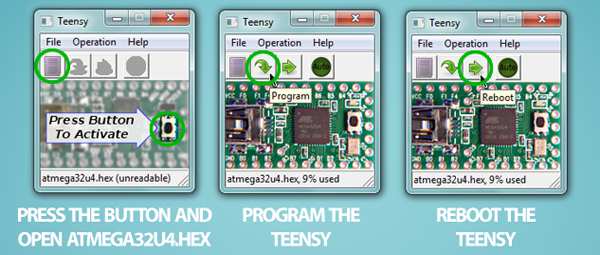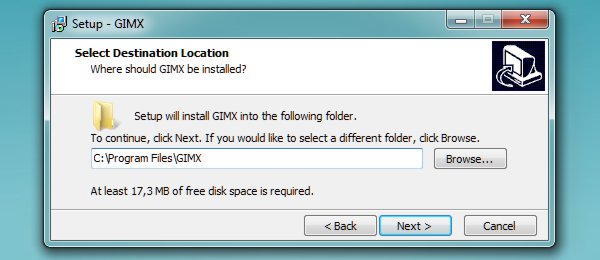|
|
(31 intermediate revisions by the same user not shown)
|
| Line 2: |
Line 2: |
| | https://gimx.fr/img/screenshots/tuto/gfd/gfd-header.png | | https://gimx.fr/img/screenshots/tuto/gfd/gfd-header.png |
| | | | |
| − | This tutorial focuses on simplicity and easiness. If you want more details, please read the [[DIY_USB_adapter]] page.
| + | Diese Anleitung fokussiert sich nur auf das wesentliche und wird einfach gehalten. Für weitere Details [[DIY_USB_adapter]]. |
| | | | |
| | {{Third_party_adapters}} | | {{Third_party_adapters}} |
| − | Welcome to the straight-to-the-point tutorial on how to build the GIMX DIY USB adapter, solderless!<br/ >
| + | Willkommen zur Schritt-für-Schritt Anleitung um einen GIMX DIY USB Adapter zu bauen, ohne zu löten!<br /> |
| − | Everything you need to know to build and get started with the adapter is covered here if you read it carefully!<br/ >
| + | Alles was man benötigt und wissen muss um um den Adapter zu bauen und bereit zu machen steht hier, wenn man es gut durch liest!<br /> |
| − | I suggest you read it through at least once, just to have a heads up on what you're going to do.
| + | Es empfiehlt sich, die Anleitung zuerst einmal durch zu lesen, bevor man damit beginnt. |
| | | | |
| − | =Get the required parts= | + | =Die benötigten Teile besorgen= |
| | | | |
| | *[http://www.ebay.com/sch/i.html?rt=nc&LH_BIN=1&_nkw=UART+Serial+Converter+CP2102 USB 2.0 to UART TTL 6PIN Module Serial Converter CP2102] | | *[http://www.ebay.com/sch/i.html?rt=nc&LH_BIN=1&_nkw=UART+Serial+Converter+CP2102 USB 2.0 to UART TTL 6PIN Module Serial Converter CP2102] |
| − | :It should come with a set of cables and look like this: | + | :Der Converter sollte mit einigen Kabeln geliefert werden und folgendermassen aussehen: |
| | https://gimx.fr/img/screenshots/tuto/gfd/gfd-cp2102.jpg<br /> | | https://gimx.fr/img/screenshots/tuto/gfd/gfd-cp2102.jpg<br /> |
| | | | |
| | *[http://pjrc.com/store/teensy_pins.html Teensy 2.0 w/ pins] | | *[http://pjrc.com/store/teensy_pins.html Teensy 2.0 w/ pins] |
| − | :You need the one with pins to be able to connect everything without soldering. | + | :Es wird zwingend ein Teensy-Board mit Pins benötigt, damit nichts gelötet werden muss. |
| − | :You can either take a Teensy 2.0 or a Teensy ++ 2.0. | + | :Es kann ein Teensy 2.0 oder ein Teensy ++ 2.0 verwendet werden. |
| − | :The other Teensy boards (3.x, LC, ...) are NOT compatible! | + | :Die anderen Teensy Boards (3.x, LC, etc..) sind NICHT kompatibel. |
| | | | |
| − | And if you don't already have it, you need to get some USB cables, like these:
| + | Falls noch nicht vorhanden, werden noch USB-Kabel wie diese benötigt: |
| | *[http://www.ebay.com/sch/i.html?_from=R40&_sacat=0&_sop=15&_nkw=shielded%20mini%20usb%20cable&_sop=15 Mini USB A Male to USB B 5 Pin Male Shielded Cable] | | *[http://www.ebay.com/sch/i.html?_from=R40&_sacat=0&_sop=15&_nkw=shielded%20mini%20usb%20cable&_sop=15 Mini USB A Male to USB B 5 Pin Male Shielded Cable] |
| | *[http://www.ebay.com/sch/i.html?LH_BIN=1&_from=R40&_sacat=0&_nkw=usb+male+to+female+extension+shielded&_sop=15 USB Male to Female Extension Shielded Cable] | | *[http://www.ebay.com/sch/i.html?LH_BIN=1&_from=R40&_sacat=0&_nkw=usb+male+to+female+extension+shielded&_sop=15 USB Male to Female Extension Shielded Cable] |
| | | | |
| | Optional: | | Optional: |
| − | *[http://www.ebay.com/sch/i.html?rt=nc&LH_BIN=1&_nkw=plastic+project+box A project box] to contain all the parts. | + | *[http://www.ebay.com/sch/i.html?rt=nc&LH_BIN=1&_nkw=plastic+project+box A project box] um alle Teile darin zu verstauen. |
| − | :I'll be using a match box for this tutorial. Another popular DIY project box is an empty Altoids tin for example. | + | :Ich werde für diese Anleitung eine Zündholzschachtel verwenden. |
| − | *Electrical tape | + | *Isolierband |
| − | :For insulating or securing parts and cables in place. Regular adhesive tape should work as well. | + | :Um die Teile zu isolieren resp. zu befestigen. |
| − | *Rubber band | + | *Gummibänder |
| − | :For bundling everything up - easy to undo and redo if you don't get it right the first time. | + | :Um alles zusammen zu halten - einfach wieder zu entfernen, falls etwas nicht stimmt. |
| | | | |
| − | And hopefully you have some basic tools like a hobby/utility knife or scissors laying around.
| + | Und Hoffentlich ist eine kleine Grundausstattung an Werkzeugen vorhanden. z.B. Messer oder Scheere. |
| | | | |
| | https://gimx.fr/img/screenshots/tuto/gfd/gfd-parts.jpg | | https://gimx.fr/img/screenshots/tuto/gfd/gfd-parts.jpg |
| | | | |
| − | '''Note: don't use retractable cables as shown in the above picture, use shielded USB cables instead.''' | + | '''Notiz: Anstelle von einziehbaren Kabeln, geschirmte USB-Kabel verwenden.''' |
| | | | |
| − | =Download the required software, firmware and drivers= | + | =Benötigte Software, Firmwares und Treiber herunterladen= |
| | | | |
| | ==Windows== | | ==Windows== |
| Line 47: |
Line 47: |
| | *[http://www.pjrc.com/teensy/loader_vista.html Teensy firmware loader] | | *[http://www.pjrc.com/teensy/loader_vista.html Teensy firmware loader] |
| | | | |
| − | For easy access later on, just save/extract all the files to your desktop.
| + | Für die einfache Handhabung alles auf den Desktop speichern resp. entpacken. |
| | | | |
| | --todo: update screenshot (CP210x drivers are included in the GIMX setup) | | --todo: update screenshot (CP210x drivers are included in the GIMX setup) |
| Line 58: |
Line 58: |
| | *[http://gimx.fr/download/gimx-firmwares Firmwares] | | *[http://gimx.fr/download/gimx-firmwares Firmwares] |
| | {{Firmwares/en}} | | {{Firmwares/en}} |
| − | *[http://www.pjrc.com/teensy/loader_linux.html Teensy firmware loader] | + | *(Um Teensy Loader mit Ubuntu zu nutzen, folgende Anleitung verwenden:[http://www.pjrc.com/teensy/loader_linux.html Teensy firmware loader]) |
| − | :(You will have to follow the instructions on that page if you want to use the Teensy Loader with Ubuntu)
| |
| | | | |
| − | =Assemble the adapter= | + | =Adapter zusammenbauen= |
| | | | |
| − | '''To begin with, carefully check that your serial converter is exactly the same as in this tutorial.'''<br /> | + | '''Bevor begonnen wird, überprüfen ob der Serielle-Konverter genau der gleiche wie in dieser Anleitung ist.'''<br /> |
| − | '''The adapter used in this tutorial is mislabeled: RXD and TXD are inverted.'''<br /> | + | '''Der Adapter in dieser Anleitung ist falsch angeschrieben: RXD und TXD sind vertauscht.'''<br /> |
| − | <span style="color:red">'''If it is not exactly the same, you may have to connect different pins:'''</span> | + | <span style="color:red">'''Falls es nicht exakt der selbe Adapter ist, müssen möglicherweise die Pins anders verbunden werden:'''</span> |
| | {| class="wikitable" | | {| class="wikitable" |
| − | | Teensy || USB to UART board | + | | Teensy || USB zu UART Board |
| | |- | | |- |
| | | GND || GND | | | GND || GND |
| Line 76: |
Line 75: |
| | |} | | |} |
| | | | |
| − | Next, I recommend you insulate the serial converter using the electrical tape if it's going to be in a tight enclosure, to avoid any shorts between it and the Teensy.
| + | Falls der Adapter in einem kleinen Gehäuse kontakt mit anderen Bauteilen herstellen könnte, ist es empfehlenswert den Seriellen-Konverte mit Isolierband zu isolieren damit keine Schäden an den Bauteilen auftreten. |
| | | | |
| | https://gimx.fr/img/screenshots/tuto/gfd/gfd-insulate.jpg | | https://gimx.fr/img/screenshots/tuto/gfd/gfd-insulate.jpg |
| | | | |
| − | Now connect the cables as shown in the picture below.
| + | Nun die Kabel wie auf dem Bild zu sehen ist verbinden. |
| − | (Notice how the Teensy is placed! Pins should point left with the USB connector pointing away from you.) | + | (Position des Teensy-Boards beachten ! Die Pins sollten nach links zeigen, mit der USB Schnittstelle weg von einem.) |
| | | | |
| | https://gimx.fr/img/screenshots/tuto/gfd/gfd-cablesgohere.jpg | | https://gimx.fr/img/screenshots/tuto/gfd/gfd-cablesgohere.jpg |
| | | | |
| − | The next two steps are only required if you're putting the parts in a very tight enclosure and need the parts to take up as little space as possible.
| + | Die nächsten zwei Schritte sind nur benötigt, wenn der Adapter in einen sehr kleinen Behälter verbaut wird und deshalb sehr klein gehalten werden muss. |
| | | | |
| − | 1. Bend the pins with the jumper cables attached to them inwards, slowly to prevent them from snapping, and tuck the cables between the pins on the opposite side. | + | 1. Die Pins an welche die Jumper-Kabel befestigt sind langsam und vorsichtig nach innen biegen damit sie nicht abbrechen. Die Kabel zwischen den Pins hindurchführen. |
| | | | |
| | https://gimx.fr/img/screenshots/tuto/gfd/gfd-bend-1.jpg | | https://gimx.fr/img/screenshots/tuto/gfd/gfd-bend-1.jpg |
| Line 109: |
Line 108: |
| | https://gimx.fr/img/screenshots/tuto/gfd/gfd-matchdapter.jpg | | https://gimx.fr/img/screenshots/tuto/gfd/gfd-matchdapter.jpg |
| | | | |
| − | Voilà! You're done building the adapter. | + | Voilà! Der Adapter ist fertig gebaut. |
| | | | |
| − | =Load the firmware onto the adapter= | + | =Firmware auf den Adapter laden= |
| | | | |
| − | Connect the adapter to your computer using the USB Mini-B cable and a LED on the Teensy should turn on or start blinking.
| + | Den Adapter mit dem USB-Mini-B-Kabel am PC anschliessen, das Teensy Board sollte starten oder zu Blinken beginnen. |
| | | | |
| | https://gimx.fr/img/screenshots/tuto/gfd/gfd-loadfirmware.png | | https://gimx.fr/img/screenshots/tuto/gfd/gfd-loadfirmware.png |
| | | | |
| − | Now start up Teensy Loader (teensy.exe on your desktop) and follow these steps:
| + | Nun den Teensy Loader starten (teensy.exe auf dem Desktop) und folgende Schritte durchführen: |
| | | | |
| | Press the button on the Teensy and the LED should turn off. | | Press the button on the Teensy and the LED should turn off. |
| Line 124: |
Line 123: |
| | Now click the Reboot button and your GIMX USB adapter is ready for use! | | Now click the Reboot button and your GIMX USB adapter is ready for use! |
| | | | |
| − | If the Teensy loader does not detect the device, try with another USB cable, and another USB port.
| + | Falls der Teensy Loader kein Gerät erkennt, sollte ein anderes USB-Kabel resp. ein anderer USB-Port genommen werden. |
| | | | |
| | https://gimx.fr/img/screenshots/tuto/gfd/gfd-connect.jpg | | https://gimx.fr/img/screenshots/tuto/gfd/gfd-connect.jpg |
| Line 132: |
Line 131: |
| | When in use, the USB Mini-B cable is connected to your console. | | When in use, the USB Mini-B cable is connected to your console. |
| | | | |
| − | =Install the GIMX software= | + | =GIMX Software installieren= |
| | | | |
| | This step is pretty straight forward. | | This step is pretty straight forward. |
| Line 139: |
Line 138: |
| | https://gimx.fr/img/screenshots/tuto/gfd/gfd-setupgimx2.jpg | | https://gimx.fr/img/screenshots/tuto/gfd/gfd-setupgimx2.jpg |
| | | | |
| − | When the installation is done you should have three GIMX icons on your desktop.
| + | Wenn die Installation abgeschlossen ist, sollten drei GIMX Icons auf dem Desktop erzeugt werden. |
| | | | |
| | --todo: update screenshot (gimx-serial was renamed to gimx-launcher) | | --todo: update screenshot (gimx-serial was renamed to gimx-launcher) |
| | https://gimx.fr/img/screenshots/tuto/gfd/gfd-icons.png | | https://gimx.fr/img/screenshots/tuto/gfd/gfd-icons.png |
| | | | |
| − | '''Configuration basics''' | + | '''Konfigurationsgrundlagen''' |
| | | | |
| | GIMX comes pre-loaded with a few configurations, but let's take a quick look on how you can make your own configurations using the GIMX FPS Config Tool (As you can tell by the name, this is mainly meant for setting up a basic FPS configuration.) | | GIMX comes pre-loaded with a few configurations, but let's take a quick look on how you can make your own configurations using the GIMX FPS Config Tool (As you can tell by the name, this is mainly meant for setting up a basic FPS configuration.) |
| Line 154: |
Line 153: |
| | NOTE! To open the configuration directory, click on File>Open config directory in gimx-config, gimx-fpsconfig, or gimx-launcher. | | NOTE! To open the configuration directory, click on File>Open config directory in gimx-config, gimx-fpsconfig, or gimx-launcher. |
| | | | |
| − | =Good to go!= | + | =Bereit zum Start!= |
| | | | |
| − | That's it. You're ready to start using the GIMX USB adapter!
| + | Fertig. Nun ist der GIMX USB-Adaper bereit für die Verwendung! |
| | | | |
| − | *Connect the regular USB side to your PC | + | *Normale USB-Siete mit dem PC verbinden |
| | | | |
| | https://gimx.fr/img/screenshots/tuto/gfd/gfd-contopc.jpg | | https://gimx.fr/img/screenshots/tuto/gfd/gfd-contopc.jpg |
| Line 176: |
Line 175: |
| | Now if you're in the menus of your console and press the WASD or arrow keys on your keyboard, you should be able to navigate through the menus, meaning you've succeeded! If not, or if something went wrong elsewhere, go back and make sure you followed every step to the letter and try again, then let us know if nothing you try works. | | Now if you're in the menus of your console and press the WASD or arrow keys on your keyboard, you should be able to navigate through the menus, meaning you've succeeded! If not, or if something went wrong elsewhere, go back and make sure you followed every step to the letter and try again, then let us know if nothing you try works. |
| | | | |
| − | Enjoy!
| + | Viel Spass! |

Diese Anleitung fokussiert sich nur auf das wesentliche und wird einfach gehalten. Für weitere Details DIY_USB_adapter.
Willkommen zur Schritt-für-Schritt Anleitung um einen GIMX DIY USB Adapter zu bauen, ohne zu löten!
Alles was man benötigt und wissen muss um um den Adapter zu bauen und bereit zu machen steht hier, wenn man es gut durch liest!
Es empfiehlt sich, die Anleitung zuerst einmal durch zu lesen, bevor man damit beginnt.
Die benötigten Teile besorgen
- Der Converter sollte mit einigen Kabeln geliefert werden und folgendermassen aussehen:

- Es wird zwingend ein Teensy-Board mit Pins benötigt, damit nichts gelötet werden muss.
- Es kann ein Teensy 2.0 oder ein Teensy ++ 2.0 verwendet werden.
- Die anderen Teensy Boards (3.x, LC, etc..) sind NICHT kompatibel.
Falls noch nicht vorhanden, werden noch USB-Kabel wie diese benötigt:
Optional:
- Ich werde für diese Anleitung eine Zündholzschachtel verwenden.
- Um die Teile zu isolieren resp. zu befestigen.
- Um alles zusammen zu halten - einfach wieder zu entfernen, falls etwas nicht stimmt.
Und Hoffentlich ist eine kleine Grundausstattung an Werkzeugen vorhanden. z.B. Messer oder Scheere.

Notiz: Anstelle von einziehbaren Kabeln, geschirmte USB-Kabel verwenden.
Benötigte Software, Firmwares und Treiber herunterladen
Windows
- EMUJOYSTICKPS3: HID joystick emulation, with 16bit stick axes, for PS3
- EMUPS3: Sixaxis emulation, for PS3
- EMU360: 360 pad emulation, for Xbox 360
- EMUPS4: Hori Pad FPS Plus emulation, for PS4 (with touchpad support)
- EMUXONE: Xbox One pad emulation, for Xbox One
- EMUG29PS4: Logitech G29 gaming wheel emulation, for PS4, with force feedback support
- EMUG27PS3: Logitech G27 gaming wheel emulation, for PS3, with force feedback support
- EMUGTFPS2: Logitech GT Force emulation, for PS2, with force feedback support
- EMUDFPS2: Logitech Driving Force emulation, for PS2, with force feedback support
- EMUDFPPS2: Logitech Driving Force Pro emulation, for PS2, with force feedback support
- EMUG27PC: Logitech G27 gaming wheel emulation, for PC, force feedback support
Für die einfache Handhabung alles auf den Desktop speichern resp. entpacken.
--todo: update screenshot (CP210x drivers are included in the GIMX setup)

Ubuntu
- EMUJOYSTICKPS3: HID joystick emulation, with 16bit stick axes, for PS3
- EMUPS3: Sixaxis emulation, for PS3
- EMU360: 360 pad emulation, for Xbox 360
- EMUPS4: Hori Pad FPS Plus emulation, for PS4 (with touchpad support)
- EMUXONE: Xbox One pad emulation, for Xbox One
- EMUG29PS4: Logitech G29 gaming wheel emulation, for PS4, with force feedback support
- EMUG27PS3: Logitech G27 gaming wheel emulation, for PS3, with force feedback support
- EMUGTFPS2: Logitech GT Force emulation, for PS2, with force feedback support
- EMUDFPS2: Logitech Driving Force emulation, for PS2, with force feedback support
- EMUDFPPS2: Logitech Driving Force Pro emulation, for PS2, with force feedback support
- EMUG27PC: Logitech G27 gaming wheel emulation, for PC, force feedback support
Adapter zusammenbauen
Bevor begonnen wird, überprüfen ob der Serielle-Konverter genau der gleiche wie in dieser Anleitung ist.
Der Adapter in dieser Anleitung ist falsch angeschrieben: RXD und TXD sind vertauscht.
Falls es nicht exakt der selbe Adapter ist, müssen möglicherweise die Pins anders verbunden werden:
| Teensy |
USB zu UART Board
|
| GND |
GND
|
| D2 |
TX / TXO / TXD
|
| D3 |
RX / RXI / RXD
|
Falls der Adapter in einem kleinen Gehäuse kontakt mit anderen Bauteilen herstellen könnte, ist es empfehlenswert den Seriellen-Konverte mit Isolierband zu isolieren damit keine Schäden an den Bauteilen auftreten.

Nun die Kabel wie auf dem Bild zu sehen ist verbinden.
(Position des Teensy-Boards beachten ! Die Pins sollten nach links zeigen, mit der USB Schnittstelle weg von einem.)

Die nächsten zwei Schritte sind nur benötigt, wenn der Adapter in einen sehr kleinen Behälter verbaut wird und deshalb sehr klein gehalten werden muss.
1. Die Pins an welche die Jumper-Kabel befestigt sind langsam und vorsichtig nach innen biegen damit sie nicht abbrechen. Die Kabel zwischen den Pins hindurchführen.

2. To save some extra space, I usually wrap the cables around the Teensy.
There's no special way of doing this, so you just need to figure out what works best for your build.
Remember not to cover up the button on the Teensy as we need to press it later on.
(Also, this is where the rubber band will come in handy!)

If you want, you can also place the serial converter so that the pins and jumper cables go in between the rows of pins on the Teensy.
It's a very snug fit though so you should use some electrical tape to insulate the pins on the serial converter because they will touch the Teensy ones if you don't.

Cut some holes in your project box of choice to match the Mini USB plug on one side and regular USB plug on the other side.
Do some tests and make sure everything aligns up before securing everything in place. In the picture below I've bundled everything up using the rubber band and secured it to the box with some electrical tape (double sided tape or hot glue works wonders too if you have it)

Voilà! Der Adapter ist fertig gebaut.
Firmware auf den Adapter laden
Den Adapter mit dem USB-Mini-B-Kabel am PC anschliessen, das Teensy Board sollte starten oder zu Blinken beginnen.

Nun den Teensy Loader starten (teensy.exe auf dem Desktop) und folgende Schritte durchführen:
Press the button on the Teensy and the LED should turn off.
In Teensy Loader, open atmega32u4.hex from the firmwares folder on your desktop.
Click the Program button and you should get the message "Download Complete"
Now click the Reboot button and your GIMX USB adapter is ready for use!
Falls der Teensy Loader kein Gerät erkennt, sollte ein anderes USB-Kabel resp. ein anderer USB-Port genommen werden.

NOTE! You can now unplug the USB Mini-B cable from your computer.
The USB Mini-B cable will only be connected to your computer when upgrading the firmware from now on.
When in use, the USB Mini-B cable is connected to your console.
GIMX Software installieren
This step is pretty straight forward.
Simply run setup-X.YZ.exe from your desktop and follow the installation steps, preferably with the default installation location.

Wenn die Installation abgeschlossen ist, sollten drei GIMX Icons auf dem Desktop erzeugt werden.
--todo: update screenshot (gimx-serial was renamed to gimx-launcher)

Konfigurationsgrundlagen
GIMX comes pre-loaded with a few configurations, but let's take a quick look on how you can make your own configurations using the GIMX FPS Config Tool (As you can tell by the name, this is mainly meant for setting up a basic FPS configuration.)
Youtube video
You can also check out the Configuration Requests and Index thread for other configurations available for download, or post requests that we or the community might be able to fulfill.
NOTE! To open the configuration directory, click on File>Open config directory in gimx-config, gimx-fpsconfig, or gimx-launcher.
Bereit zum Start!
Fertig. Nun ist der GIMX USB-Adaper bereit für die Verwendung!
- Normale USB-Siete mit dem PC verbinden

- Connect the USB Mini-B side to your console, run gimx-launcher and make sure the adapter is recognized on a COM port.
- (If the Device box is blank, refer to the Support section and report the problem if a solution isn't found)

- Read the Quick Start page to learn how to download a pre-made configuration, and how to install the libusbk driver (needed for consoles that require authentication).
- Select the config you made/downloaded from the drop down menu, click the Start button and a couple of windows should pop up to start capturing your mouse and keyboard input!
If there is a "No controller detected." error message when you start GIMX, double check you wiring, and try to invert TX and RX in case it's still not working.

Now if you're in the menus of your console and press the WASD or arrow keys on your keyboard, you should be able to navigate through the menus, meaning you've succeeded! If not, or if something went wrong elsewhere, go back and make sure you followed every step to the letter and try again, then let us know if nothing you try works.
Viel Spass!













![]()


